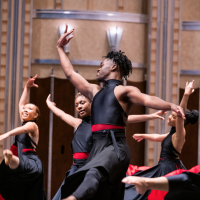The auditorium was dark, half-filled and almost silent. The only light came from colorful images flashed in three-second bursts across the large screen on stage. The only sound was that of thoughtful comments from the seven judges and one facilitator, also on stage.
“We’ll begin with the first reviewer.”
“A very well-developed style and skill, but derivative of another artist.”
“A practical business plan about how to spend the money, but not much about how the artist wants to move ahead creatively.”
“I found the works quirky – but in a good way. I wanted to keep looking at them, to understand more.”
“The application was almost blank. I consider that a negative. I want to understand the circumstances from which the work emerges.”
“The work is a little ironic, a little absurd. The artist has a peculiar personal vision. I like how I don’t know how to pin them down.”
“The work feels corporate: more of an illustration, less of a conceptual nature. I wanted to see a more personal investment – more risk is needed to move the work forward.”
These were some of the comments made by the panel of outside arts experts convened by the Community Partnership for Arts and Culture to adjudicate the historic first round of applications for individual artist fellowships in Cuyahoga County. The judging of more than 250 applicants for just twenty $20,000 Creative Workforce Fellowships in visual and media arts took place over two days this week in the lovely Greg L. Reese concert hall of the East Cleveland Public Library. Check out CPAC’s web site for current information on the award process and for an announcement of the winners.
I was able to spend just a few hours with the artists sitting in the darkened hall and watched the panel move through about 50 applications in that time. This was just the first round – to winnow the large group into “fellowship-ready” or “not fellowship-ready” categories – so some heavy elimination needed to take place. The resulting smaller group would then be reviewed again to determine the lucky 20 finalists.
By my count, the panel was on track to eliminate 70 percent of the applicants in this first cut. Interestingly, the applications that got the most comments were the ones that did not make the cut, with the panel taking pains to identify strengths and make helpful comments about weaknesses.
There were often very few comments about the applicants who received the necessary four of seven votes to advance to the next round. After the facilitator would intone, “All those who would like to see this applicant move to the next round, raise your hands,” hands would go up (or not), and the next applicant’s slides would appear. Throughout the auditorium, artists would scribble and whisper, the next group of images would flash quickly by, and this quirky public jury process would move smoothly on.
